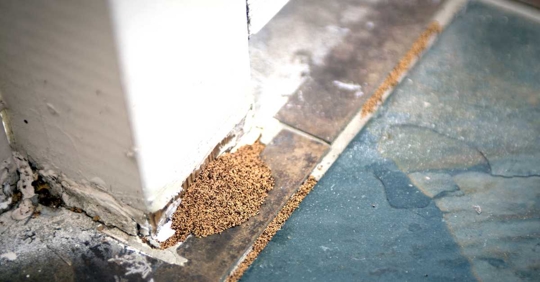In Mississippi's warm, humid climate, subterranean termites thrive. These pests typically build colonies underground and find their way into homes through soil contact, foundation cracks, or wood-to-ground contact. Once inside, they quietly feed on structural wood, often causing significant damage before a homeowner notices any signs.
Because of how discreet termites are, most infestations are only discovered during home renovations, real estate inspections, or after visible damage appears. Early detection and professional treatment are key to minimizing long-term impact.
Concerned about hidden damage? Explore our termite treatment options or call (228) 338-6365 to speak with a local expert about protecting your home.
1. Hollow or Damaged Wood
When termites consume wood, they often eat it from the inside out. This leaves a thin layer of wood or paint on the surface, while the interior becomes hollow. You might not see the damage immediately, but tapping on baseboards, beams, or floors could reveal a hollow or papery sound.
If the wood crumbles easily when touched or reveals tunnels just below the surface, that’s a strong sign of termite activity. Sometimes, the wood may appear blistered or bubbled, often mistaken for water damage.
2. Warped or Sagging Floors, Walls, or Ceilings
Another potential indicator of termites is unusual warping in your home’s structure. As termites consume the wood within walls, floors, or ceilings, the support behind these areas weakens. Over time, you may notice areas that feel soft underfoot, bulging walls, or doors and windows that no longer close properly.
These changes can develop gradually and may resemble other issues like water damage or foundation settling. However, in the context of a termite-prone area, they shouldn’t be ignored.
3. Mud Tubes on Your Home’s Exterior or Foundation
Subterranean termites need protection from dry air, so they build narrow mud tubes to travel between their colony and food source. These small, tunnel-like structures are often found along a home’s foundation, in crawl spaces, or under porches. Look for mud tubes in areas such as:
- Concrete slab joints
- Crawl space supports
- Along exterior brick or siding
- Near utility lines entering the home
If you see a mud tube, it may be dry or active. Avoid destroying them before a professional inspection, as that can interfere with detecting the extent of the infestation.
4. Clicking or Rustling Sounds from Walls
While termites are quiet, they’re not entirely silent. If you put your ear close to a wall or wooden structure during a quiet time of day, you might hear faint tapping, clicking, or rustling sounds. These noises can be caused by:
- Soldier termites banging their heads to communicate danger
- Worker termites chewing through wood continuously
Though not always noticeable, any strange, unexplained sounds coming from inside your walls, especially if paired with other warning signs, may indicate a hidden infestation.
5. Discarded Wings Near Entry Points
During the termite swarming season, reproductive termites (called alates) fly out of their colonies to start new ones. Once they find a suitable spot, they shed their wings. Piles of these tiny wings, which are all roughly the same size and shape, can often be found near windowsills, doorways, or exterior lighting.
This is a key sign that termites have either entered your home or are active nearby. Swarming usually occurs in the spring or early summer, particularly after a warm rain.
6. Stuck Doors or Windows
Have your doors or windows recently started sticking, even though your home hasn’t shifted or experienced extreme humidity? This could be caused by moisture buildup from termite activity. As termites eat through wood, the damage and moisture they introduce can cause the frames to warp.
While a single sticking door doesn’t always point to termites, several around the home—especially in wood-framed areas—should raise concern.
What to Do if You See Signs of Termites
If you’ve noticed one or more of these issues, it’s important not to delay. Termite damage rarely gets better on its own and is not something that can be effectively managed with DIY solutions.Take these steps if you suspect termite activity:
- Contact a professional for an inspection. A licensed technician can confirm the presence of termites and identify hidden damage that may not be visible during a surface-level check.
- Avoid disturbing the affected areas. Attempting to remove mud tubes or open up damaged wood can cause the colony to retreat, making treatment more difficult.
- Review a treatment and prevention plan. A pest professional will offer targeted solutions, such as liquid barrier treatments or baiting systems, depending on your home’s layout and infestation level.
Homes built more than 20 years ago, especially those with crawl spaces or direct wood-to-soil contact, are at greater risk for termites. The Mississippi Gulf Coast’s high moisture levels only increase the likelihood of infestations.
Regular inspections, moisture control, and early detection go a long way in protecting your property from long-term termite damage. Scheduling an annual inspection is a smart choice for homeowners living in high-risk areas like Gulfport and Ocean Springs.
Stay Protected with Insecteco Pest Company
At Insecteco Pest Company, our team works with homeowners across the Mississippi Gulf Coast to detect termite issues early and provide reliable treatment options. Whether you’re concerned about visible signs of damage or just want to stay ahead of potential issues, we’re here to help.
If you’ve noticed any of the signs above or want to schedule a routine inspection, reach out to us through our online contact form or call (228) 338-6365 today. Let’s take the right steps to protect your home.

